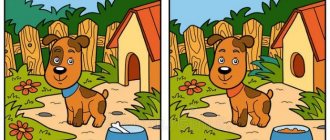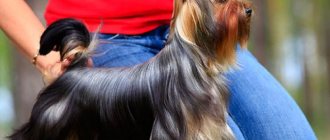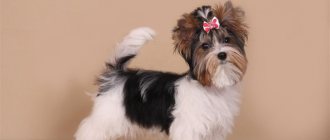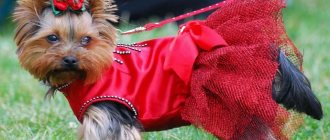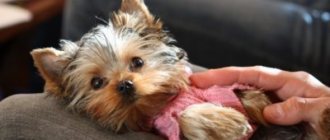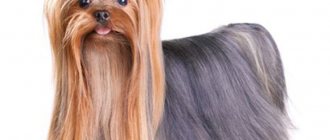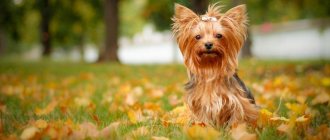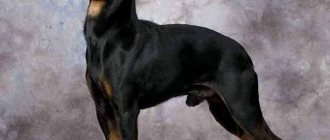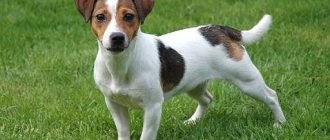Demand for tiny babies
Until recently, the presence of a Yorkie puppy indicated a certain status of its owner. Only a truly wealthy person could afford to own this miracle. More and more people who want to acquire them are not deprived of the opportunity to make their dreams come true.
I would like to believe that the financial condition of the majority of the population has improved, but the factor of change was that the population of representatives of this breed has increased quantitatively, and this has led to a decrease in the value of each individual individual.
Now even those who do not have a high level of income, but dream of a little friend, can get one.
Take the Attention Test! Find 10 differences! (click right here!)
Find the answer Are you bothered by some problem or question? Enter “Breed” or “Name of the problem” into the form, press Enter and you will find out everything about the issue that interests you.
The advantages of tiny animals
Firstly, from the amazingly sharp minds of these graceful babies, who are easy to train and easily remember and perform the most difficult tricks. Yorkie owners note that their pets are not just smart, but intelligent. They are characterized not by the usual memorization of commands, the standard response to intonation, but by a clear understanding of words. If a Yorkie wants to go for a walk or play, he will indicate this to the owner by bringing him the necessary attribute.
The advantages include the modest size of the breed. Their weight does not exceed 3 kg, but inside they have a big loving heart beating, full of tenderness and awe towards their owners. They are excellent companions, showing attention and sensitivity. A small Yorkie will not claim a huge amount of personal space, so a pad in a secluded corner will be enough.
Easily transportable. He will be able to keep company on any trip, and this eliminates the problem of who to entrust to look after the pet while he is away. Yorkies feel great in transport and can even handle long distance trips without any problems. To transport it, you don’t need to have a special carrying bag for dogs; these couple of kilograms of happiness will feel comfortable in an ordinary handbag or just in your arms.
Pros and cons of the mini Yorkshire Terrier
Having decided to get a Yorkshire terrier dog, future owners are faced with the question - should they get a Yorkie that fully meets the breed standards or give preference to miniature representatives of the breed - mini-Yorks? Miniature Yorkies (super-mini), as the name suggests, differ from the established breed standard by being significantly smaller in size. The weight of babies does not exceed 1.3 - 2 kg. Let us remind you that the weight of “standard” Yorkies is from 1.8 to 3.2 kg. It is weight that is the main criterion that determines the varieties (subtypes) of this breed. According to this parameter, dogs of the mini subtype are classified into super-mini, which have miniature, tiny sizes (weight up to 1.3 kg) and mini-Yorks with a weight from 1.3-1.5 to 2 kg. At the same time, miniature Yorkshire terriers, along with their standard-sized counterparts, have the right to take part in exhibitions and various competitions. Given the growing interest in this variety of the popular breed, in this section we will look at the advantages and disadvantages of Mini Yorkies.
Advantages of Mini Yorkies
The most striking advantage and difference between miniature Yorkies and representatives of the breed standard can be considered the calmer, balanced, absolutely not “terrier” character of miniature dogs. Mini Yorkies have a very affectionate disposition, good-natured temperament, and get along well with other pets and their relatives. Their hunting instincts are not as developed as those of the standard type, so Mini Yorkies will not bark over trifles when they hear sounds outside the door, pester large dogs on the street, or chase a cat around the house. They are very attached to all members of their family, and will become an excellent companion and companion for older people who prefer quiet communication with their pets to active walks.
It is known that Yorkies require increased attention, trying to always be in sight. Mini Yorkies are less intrusive and emotional. Due to their calm disposition, they will not bother you, imposing their company on the owner. Thanks to their miniature dimensions, dogs can be taken on trips, observing the rules for transporting dogs, and visiting public places, unless prohibited by established rules.
Mini Yorkies are very clean and are much easier and faster to litter train than midi or standard Yorkshire terriers. The coat of miniature dogs is not so long and thick, so caring for the coat is much easier. They do not shed seasonally. Its modest size allows you to keep a dog even in small apartments. Mini Yorkies are highly intelligent, smart, and amenable to training and upbringing.
Disadvantages of Mini Yorkies
Like most selective breeds, Mini Yorkies cannot boast of excellent health. Among representatives of this species, there are often dogs with congenital defects and health problems that can appear at any age. Most often, hypoglycemia is observed in puppies of miniature varieties. This does not mean that it is impossible to acquire a completely healthy pet. You can find a completely healthy Mini Yorkie in specialized nurseries, from trusted breeders who breed and pay great attention to the selection of this breed. It is best to pick up babies from breeders at the age of two to three months. In mini-Yorks, unlike standard ones, the “fontanel” closes much later, which poses a great danger to tiny creatures.
The second problem is related to the miniature size of dogs. Mini Yorkies require a delicate, careful attitude and are more susceptible to various types of injuries. You should not have miniature pets in a house where there are already large dogs or small children who may accidentally injure their pet while playing. Even a soft toy can become a source of danger for a tiny pet, and this is not to mention jumping or falling from a small height or violent displays of love by young owners. In this case, it is better to give preference to standard Yorkshire terriers. Particular attention should be paid during walks, without letting the baby out of your sight - large and even medium-sized dogs can harm a tiny terrier.
Mini Yorkies do not tolerate loneliness or long-term separation from their owner. they feel more comfortable and safe sitting on the laps or hands of their owner. Leaving your pet alone for a long time can cause psychological trauma.
Despite their affectionate, calmer temperament, Mini Yorkshire Terriers can be capricious and stubborn. Mini Yorkies eat little, but can be picky about food, so from an early age you need to choose the ideal diet in all respects and strictly adhere to the regime and daily routine. Under no circumstances should you overfeed your pet or give treats from your table. Even the smallest piece of forbidden “yummy” can lead to disruption of digestive processes, and in the future cause disruptions in the functioning of the endocrine system.
Mini Yorkies are not suitable for breeding. Due to their miniature size, pregnancy and childbirth place a lot of stress on a tiny dog’s body and can cause death. Therefore, if you plan to breed the breed, give preference to standard-sized Yorkshire terriers.
The last drawback is the high cost of miniature Yorkshire terrier puppies. If you are offered to purchase a puppy at the cost of standard Yorkshire terriers, you can be sure that you are looking at either a problem puppy or a representative of the standard subtype.
Possible disadvantages of miniature Yorkies
More than once we have to face the fact that an undoubted plus, under a certain set of circumstances, turns into a fairly significant minus. So it is with representatives of such a breed as the Yorkshire Terrier, when the dog’s sharp mind, recognized as a plus, turns into a minus for the owner, when the pet is not in the mood and wants to be capricious. At such moments, the Yorkie finds thousands of possible reasons for disobedience.
From banal attacks of poor health, lack of understanding of what they even want from him, to more sophisticated techniques. Showing enviable stubbornness.
The downside is the independent character of the dog, despite the all-consuming love for its owners, it tries in every possible way to prove its self-sufficiency, as if showing that it can do without their presence in its life. Another disadvantage, which originates from the undoubted advantage of the breed, is the modest size of the dog. Due to the natural fragility of this pet, it is easy to hurt, even without meaning to. From an early age, the Yorkie should be taught to sleep in a place allocated for him, which is located in the least visited part of the living space.
There is no need to leave it in the care of young children, who, while playing, without calculating their strength, can injure the dog. Despite his modest size, he considers himself a great hunter. Which is not surprising, since this breed was originally bred not as a decorative species, but as a hunting species. Feeling insulted or offended, without a twinge of conscience he can bite in revenge. Which once again indicates that adults should not allow young family members to torment or tease their pet, even playfully.
The downside is that Yorkies have an incredibly weak digestive system. It is forbidden to feed Yorkshire terriers from the “common table”. Special high-quality food causes severe stomach upset in babies. It is important to monitor whether the pet has overeaten or whether the food portions are too small.
The next disadvantage that I would like to talk about concerns the social spheres of life. Yorkies are incredibly active and make a lot of noise around them. They like to bark loudly and tastefully, which is not always to the liking of the residents of neighboring apartments. The dog, having a keen sense of smell and sensitive hearing, will react loudly to any extraneous noise, believing that it cares about the safety of its owners. On the street, a small bully may try to get into a fight even with representatives of large breeds, which is also fraught with inconvenience.
Yes, the breed is rich in both positive and negative characteristics. You can compare one with another ad infinitum. Therefore, those who want to get this pet should carefully weigh the pros and cons. By purchasing any living creature, not a new toy will appear in your life, but a family member.
Hair and teeth care
They are so cute largely due to their long, silky fur. The undeniable advantage of the breed is that it does not cause allergies and does not shed.
But complex and lengthy grooming should be considered one of the disadvantages of the breed.
The owner will have to monitor the fur, and do this quite regularly and carefully. Some owners make their lives easier by bringing their Yorkies to the hairdresser for a haircut, and not only in the summer.
It's a pity, because dogs of this breed lose most of their charm when they are cut, and a visit to the hairdresser is not cheap.
In order for the Yorkie's coat to be their decoration, and not just a natural feature, it needs to be bathed every week using special products.
After washing the pet, dry it with a hairdryer and begin thorough combing and styling.
In addition to grooming, the owner will have to clean the dog’s eyes and ears and trim the hair near the ears for hygiene purposes. Frequent nail trimming is also necessary as they grow back faster than usual.
If the owner is unable to cope with hygiene care on his own, then he will have to seriously spend money and turn to specialists for help. The cost of care professionals is undoubtedly a significant disadvantage of owning a Yorkshire terrier .
The weak point of the breed is also considered to be their teeth. Even as teeth grow, problems may arise and it is better to consult a veterinarian in advance about proper care.
After teeth have formed, you will need to carefully and systematically treat the oral cavity to prevent the formation of tartar and tooth loss.
History of the origin of the breed
Looking at these cuties, only one version comes to mind - this breed was carefully bred so that the dogs would delight high-ranking owners with their presence. Representatives of this breed are by no means natives of secular salons. And Yorkshire terriers also cannot boast of an ancient history.
According to reliable information, these dogs were bred by workers in the coal mines of the small town of West Rydenga, which was located in the Yorkshire-Nottingham coalfield. And the task before the Yorks was not an easy one - to destroy the crowds of rodents living in the mines, and to search for accumulations of ore gases. They turned out to be excellent rat catchers; bypassing the law prohibiting the appearance of animals in mines, they successfully entered there in the sleeves of workers.
But this turn in the history of the breed turned out to be short-lived, the cuties were noticed by ladies from high society and quickly, leaving the coal mines, they became guests of salons and boudoirs.
In the 19th century, under Queen Victoria, it was bad manners to attend social events without a tiny pet in your arms. And the smaller the pet was, the more it was valued and aroused envious glances.
But the documented history of the breed began in the 70s of the 19th century, when the English Kennel Club was organized and the Great Britain stud book appeared. The club officially recognized the breed only in 1986, when the dogs were called “Yorkshire terriers.” The adoption of the standard occurred later, after 12 years.
The founder of the breed is considered to be P. Eden, an expert on various dog breeds. He acted as an expert at various dog shows, where the first representatives of the breed were presented. He was also the owner of a Yorkie named Albert, who was the first to be included in the Stud Book of Great Britain. The dog turned out to be an excellent founder of the family and passed on excellent character traits and beautiful fur to many of his descendants. Albert was a prize-winner of various exhibitions 74 times.
Yorkie color
More often they are blue-silver in color on the body and tail, and in the area of the head and sternum the color of the coat resembles a golden tan, sometimes it is creamy-golden.
There are purebred representatives of other colors: their predominant coat is black, or a combination of black and fiery shades.
Puppies of this breed are born with black fur, and only on the face and paws there are small bright red spots. Multi-colored Yorkies are much more expensive, their coat looks luxurious, as if the dog visited the salon and came out with fashionable coloring.
Terrier care
When purchasing this tiny, affectionate creature, you should rely on your strength and have free time; the appearance of terriers requires careful care.
Wool is an important item in caring for a pet. Yorkies have a gentle, long, capricious look. It will be beautiful and attractive only with constant combing. If you can’t do this every day, you can cut your pet’s hair; fortunately, salons offer a lot of model haircuts for Yorkies.
The coat requires frequent bathing, this should be done every 7-10 days. It is most convenient to carry out the procedure in the bathroom, avoiding the contact of elastic jets of water on the dog; this may frighten the Yorkie. It is better to use detergents; in extreme cases, you can use mild shampoo for children, but first dilute it with water. To improve the quality of the coat and make it easier to comb, you need to apply a balm or rinse for dogs to the coat, and then rinse it thoroughly. All actions should be carried out in the direction of hair growth.
After taking a bath, your pet should be dried with a hairdryer, wrapped in a towel or diaper. After drying, you should immediately take care of the hairstyle, combing your pet, and spray the fur with spray. If you wish, you can curl the strands with curlers.
The eyes require daily care; they should be wiped in the morning with a swab dipped in water and the fur should be combed down so that individual hairs do not injure the eyes.
Yorkies' ears are not so demanding; it is enough to inspect them once every 7 days and clean the plaque that has formed with a cotton swab and a special lotion or liquid. Care should be taken; penetration too deep will cause injury to the auricle. Hyperemia of the ear or the appearance of an unpleasant odor is the reason for contacting a veterinarian.
The nose of Yorkies, like other dogs, is an indicator of health. A healthy pet's earlobe is moist and cool. The formation of a white border or the appearance of copious discharge should alarm the owner.
Minuses
A significant part of the difficulties is associated with caring for the Yorkshire Terrier. However, it is easy to notice not always pleasant features in character and behavior. The negative aspects of the breed are:
- Coat care - a long “skirt” requires braiding and regular combing. The short coat is maintained by grooming by groomers.
- Possible health problems - dogs of modest size are prone to specific diseases and defects.
- Stubbornness is a trait of all terriers that you need to know how to handle.
- Selecting a special food - there should be small granules, the presence of all nutrients and beneficial substances that are well absorbed.
- When purchasing and using cosmetics, only high-quality products maintain the beauty of the coat.
- Dental care – narrow jaw, small teeth often lead to tartar formation.
It is possible to cope with all problems in 99% of cases, especially if timely prevention is carried out. Every dog needs coat and dental care, and for decorative breeds this is strictly necessary. The Yorkie's hair type is not the same as that of a German Shepherd or Great Dane; it does not keep you warm in cold weather and does not protect you from precipitation, so clothing for your pet is necessary.
Important! Yorkies are at risk for hypoglycemia (a sudden drop in blood sugar), which can be fatal. This is facilitated by a rapid metabolism, and frequent and regular feeding of balanced foods will help to avoid hypoglycemia.
How much does a puppy cost?
The cost of puppies depends on their size. The smaller the puppy, the more expensive it is. For example, in the capital, a one and a half kilogram baby can cost 25,000 rubles, but from private breeders it can cost less - 15,000-18,000. Larger babies in well-known nurseries cost about 12,000-15,000 rubles.
In provincial cities, the price of dogs of this breed is affordable. Depending on the size, color and title of the parents, the price of a puppy is from 7,500 to 20,000 rubles. Statistics show that Russia has the most affordable price for Yorkie puppies. This is due to the high demand and prevalence of the breed.
The Yorkshire Terrier is not a guard, bodyguard or hunter. This is a companion dog, a friend and even an equal member of the family. It is purchased for the soul and for pleasant company. But we should not forget about his terrier roots and the appearance of an aristocrat, which requires an investment of money and time.
Very small dog
The Yorkshire Terrier cannot boast of impressive dimensions. For this they are called lap dogs.
Due to their miniature size, dogs of this breed are easy to keep even when your apartment is not the most spacious..
After all, they will need very little space. This could be a pillow, a basket, or any small cozy place chosen by a caring owner.
We've all seen a Yorkshire terrier peeking curiously out of a lady's handbag more than once. An undoubted advantage of the breed is the ability not to be separated from him when you leave home for some event.
The Yorkshire Terrier is often taken with you on a visit or to a restaurant, where the owners and visitors do not mind your pet.
The paradox is that the Yorkshire Terrier combines the pros and cons of the breed, when a positive sign in one case turns into a serious cause for concern for the owner in another. We mean the pet's miniature size and the owner's constant fears for this baby.
Their fragility and lively temperament make Yorkies vulnerable and prone to injury. For example, a dog can get a dislocated or broken paw simply by jumping off the sofa, or carelessly getting under the feet of rushing household members.
Baby face
Separately, I would like to note one of the varieties of this breed - “baby face” (translated from English as a child’s face). They achieved great popularity thanks to their shorter muzzle and large eyes, all of which together gives the expression of their muzzle childlike features. If compared with the standards, the skull of the “face” is more rounded, the muzzle is shorter, the ears are set lower, the eyes are large and bulging with a surprised expression.
Baby faces are not used for exhibitions; they do not fall under any classic standard parameters. Due to their bulging eyes, “faces” suffer from chronic conjunctivitis and narrowing of the tear duct. In a dream, it can make a sound similar to snoring and grunt during active games. This is due to the shortened muzzle.
Feeding the dog
It is recommended to feed a puppy up to six months of age 4-5 times a day, and after that - no more than 3 times. Adult Yorkies eat 2 times a day. At one time, the animal is given food at the rate of one tablespoon per 500 grams of weight. The simplest and least troublesome type of food is industrial food (dry food and canned food).
It already contains all the necessary products, vitamins and minerals. The main thing is to choose high-quality and proven food that will not cause allergies and disrupt the functioning of the gastrointestinal tract. When choosing a natural feeding method, you should think about proper and balanced nutrition. To do this, your daily diet should include freshly prepared meals with added vitamins and minerals. To create such a menu, contact your veterinarian.
Features of care and maintenance
Owners of Yorkshire terriers should know how to properly wash a smooth-coated dog themselves or trust a professional groomer. At home, you need to complete several steps:
- comb and untangle tangles (remove hair curlers);
- insert cotton swabs into the dog’s ears;
- wet the wool;
- dilute the shampoo and lather the dog, avoiding getting water and foam into the eyes, mouth, nose and ears;
- rinse and repeat the procedure;
- apply conditioner or mask, leave in accordance with instructions;
- rinse and wrap the pet in a terry towel;
- Dry the strands with a warm (not hot!) and not powerful stream of air from a hair dryer, pulling them out with a comb;
- optionally - apply leave-in conditioner and braid into curler curls.
Only long strands are wound onto curling irons to preserve the wool. They are removed and re-winded daily. This method is used for show dogs; they are not cut, only the skirt is trimmed and the paws are carefully trimmed with scissors. For other Yorkies, short hair is comfortable. Then it doesn’t get tangled, it’s easier to comb it, and this needs to be done several times a week. There are many types of haircuts to suit every taste. In addition, a competent specialist will hide shortcomings and emphasize advantages.
Teeth must be cleaned with special products from a veterinary pharmacy. You can give them chicken necks or small beef cartilages to chew on. Tartar is removed only in a veterinary clinic using ultrasound or mechanical means. Caring for the ears of a healthy animal does not require much effort: periodically checking the condition and cutting the hair. Dark plaque, bad odor, redness, itching are reasons to consult a veterinarian.
Nutrition
Many major manufacturers have created special food for Yorkshire terriers. They should not contain excess fat or large granules, but are selected individually according to the condition and age of the animal. From natural foods, it is better to give preference to beef or turkey (allergic reactions to chicken are more common), vegetables, fruits and a small amount of rice or buckwheat porridge. Several times a week the menu includes cottage cheese, kefir, fermented baked milk and similar low-fat fermented milk products. Feeding frequency and digestive system are related; Yorkies are usually fed 3 times a day.
In general, dogs of this breed do not cause serious problems to their owners. It is enough to make it a rule to regularly care for the coat and teeth, start raising the puppy from the first days in the house with the help of affection, and the little pet will grow up to be a devoted and beautiful friend. When choosing who is better: a Yorkshire terrier or a pug, a Russian toy, a Shih Tzu cannot be called a clear leader, because all breeds are different and have their own characteristics. It is important to find a breeder who will sell a puppy with a strong psyche and good health. Definitely, the Yorkshire Terrier is the dog of those who value loyalty and love to care for their pets’ fur.
Basic health knowledge
In order for your Yorkie to have every chance of avoiding most diseases, you need to monitor his health and feed him properly. For a dog of this breed, the correct balance in the diet is important, with enough vitamins.
If you feed your pet with ready-made food, then you need to buy only high-quality food. Unlike cheap brands, these foods contain the right amount of vitamins, minerals and other vital substances.
If your Yorkie's diet consists of natural food, you should know what vitamins are contained in a particular product. Here are some examples:
- Vitamin A: apples, carrots, liver;
- Vitamin B: liver, yeast;
- Vitamin C: tomatoes, liver, kidneys;
- Vitamin D: cottage cheese, cheese, vegetable oil;
- Vitamin E: vegetable oil, olive oil;
- Vitamin K: lettuce, nettle.
In addition to natural foods, you will have to add multivitamin complexes to your food. “Trivit” with a high content of vitamins A, D, E is suitable.
But not a single animal is immune from any disease. Let's look at the most common diseases of Yorkshire terriers.
General characteristics
Cute in appearance and persistent in character, Yorkshire terriers have won many hearts, becoming home decorations and friends for children. The dogs of this breed are given a special nobility by their long and luxurious hair, which falls evenly to the ground.
A small dog with great pleasure will accompany its owner anywhere and bark loudly if it senses danger. It would seem that you couldn’t find a better pet. But against such a beautiful background there are a few spots of imperfections. The most striking disadvantages of a dog are stubbornness and dominance.
But the list of advantages and disadvantages of Yorkies does not end there. Therefore, before you decide to buy a puppy, you need to think carefully about whether you can cope with such an animal or not, whether you have enough patience, strength and time.
So that you fully understand what a dog like a Yorkshire Terrier is, we will look at the pros and cons of the breed below.
